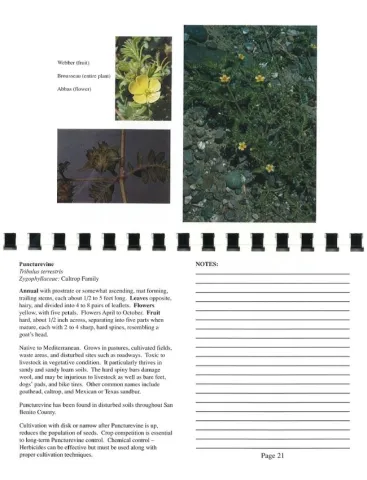Way back in the early 2000s (we think…there's no date on it!) the San Benito County Weed Management Area developed a great weed guide for our area called Selected Invasive Weeds of San Benito County: A Field Identification Guide. It contains twenty five of the most common weed species in the county. For each weed there is information about what it looks like, where it's from, where you can expect to find it, and a brief paragraph about how it can be controlled. The guide is handy because it's small enough to stick in your back pocket or put on the passenger seat of your truck to take into the field with you. Unfortunately, there are only a handful of copies left and people still need the information. But, don't worry! I recently scanned the weed guide and put the pdf on my website. Click here to open the pdf.
Below is an image of the puncturevine page from the weed guide with photos showing the hard, spiny seeds and yellow flowers that look a bit like buttercups. The weed guide explains that puncturevine is toxic to livestock and can be controlled primarily by a combination of cultivation and competition (i.e. maintaining enough other vegetation in the field to compete with it). Herbicide can be effective, but it would need to be in conjunction with cultivation.

If we are able to move forward, we plan to expand the guide to include weeds from all counties on the Central Coast. People would be able to find weeds by flower color and location. We are also considering converting it into an ap for your mobile phone. Would you use the new weed guide if we are able to produce it? If so, please let us know whether you would prefer a to have hard copy version, an electronic version (an ap), or if you would prefer to have both options available. Click here to complete the 2-question survey!
References
DiTomaso, J.M., G.B. Kyser et al. 2013. Weed Control in Natural Areas in the Western United States. Weed Research and Information Center, University of California. 544 pp. http://wric.ucdavis.edu/information/natural%20areas/wr_T/Tribulus.pdf accessed April 13, 2018.
DiTomaso, J.M., G.B. Kyser et al. 2013.Weed Control in Natural Areas in the Western United States. Weed Research and Information Center, University of California. 544 pp. http://wric.ucdavis.edu/information/natural%20areas/wr_B/Brassica_tournefortii.pdf accessed February 12, 2018.

